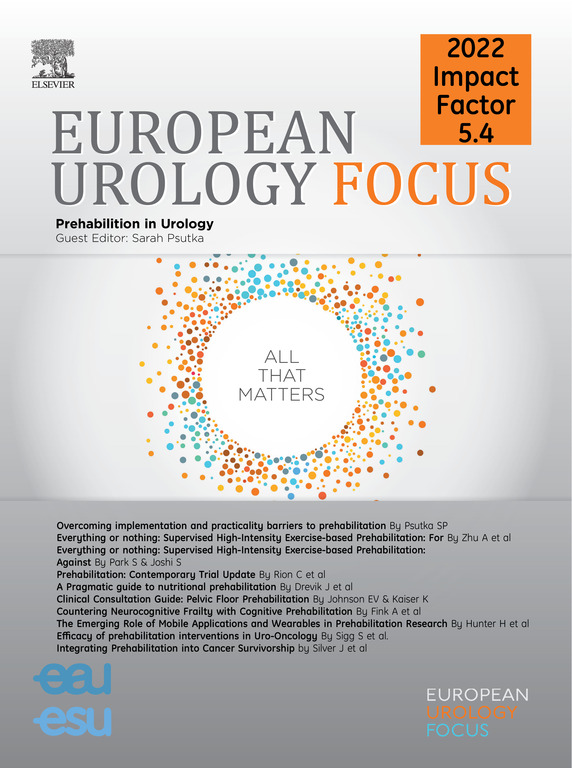Serum Levels of MicroRNA-371a-3p for Predicting the Histology of Postchemotherapy Residual Masses of Germ Cell Tumours
IF 5.6
2区 医学
Q1 UROLOGY & NEPHROLOGY
引用次数: 0
Abstract
Background and objective
Serum levels of microRNA-371a-3p (M371) represent a novel and sensitive biomarker of germ cell tumours (GCTs). This study analysed the utility of M371 to identify viable cancer (VC) in postchemotherapy (pc) residual masses with the underlying goal of avoiding overtreatment.
Methods
A multicentric, prospective diagnostic study was conducted in 180 GCT patients undergoing pc resection of residual masses. A correlation of M371 measurement results with the histological presence of VC in masses was found. A receiver operating characteristic analysis was performed for exploring the performance characteristics of the test.
Key findings and limitations
The sensitivity was found to be 68.9%, specificity 99.3%, area under the curve 0.813, positive predictive value 0.969, and negative predictive value 0.905; sensitivity is significantly associated with the percentage of VC in the mass. In specimens with ≤10% VC, there were 33.3% elevated M371 levels as opposed to 85.7% in specimens with >50% VC. Teratoma and somatic-type malignancy do not express M371. A lack of a central pathological review is a limitation.
Conclusions and clinical implications
The M371 test can identify 68.9% of patients with VC in pc masses. However, cases with <10% VC in the mass may escape detection. Teratoma does not express M371. The test alone cannot correctly identify patients requiring pc surgery, but it may be a tool for scheduling the extent of surgery.
Patient summary
The microRNA-371a-3p (M371) test can identify about two-thirds of patients with viable cancer in residual metastatic masses following chemotherapy for germ cell tumours. Only masses with high percentages of viable cancer cells can be identified, and the histological subtype teratoma remains undetected with the test.
预测生殖细胞肿瘤化疗后残留肿块组织学的血清 MicroRNA-371a-3p 水平
背景和目的:血清中的microRNA-371a-3p(M371)水平是生殖细胞肿瘤(GCTs)的一种新型、敏感的生物标志物。本研究分析了 M371 在化疗后残留肿块中识别存活癌(VC)的作用,其根本目的是避免过度治疗:方法:对180名接受化疗后残留肿块切除术的GCT患者进行了一项多中心、前瞻性诊断研究。研究发现,M371测量结果与组织学上肿块中是否存在VC存在相关性。为探索该检测的性能特征,进行了接收者操作特征分析:灵敏度为 68.9%,特异性为 99.3%,曲线下面积为 0.813,阳性预测值为 0.969,阴性预测值为 0.905;灵敏度与肿块中 VC 的百分比显著相关。在 VC≤10% 的标本中,M371 水平升高的占 33.3%,而在 VC >50% 的标本中,M371 水平升高的占 85.7%。畸胎瘤和体细胞型恶性肿瘤不表达 M371。结论和临床意义:M371检测可识别68.9%的pc蛋蛋群VC患者。患者总结:microRNA-371a-3p(M371)检测可识别约三分之二生殖细胞瘤化疗后残留转移肿块中的存活癌患者。只有存活癌细胞比例较高的肿块才能被识别出来,组织学亚型畸胎瘤仍无法通过该检测发现。
本文章由计算机程序翻译,如有差异,请以英文原文为准。
求助全文
约1分钟内获得全文
求助全文
来源期刊

European urology focus
Medicine-Urology
CiteScore
10.40
自引率
3.70%
发文量
274
审稿时长
23 days
期刊介绍:
European Urology Focus is a new sister journal to European Urology and an official publication of the European Association of Urology (EAU).
EU Focus will publish original articles, opinion piece editorials and topical reviews on a wide range of urological issues such as oncology, functional urology, reconstructive urology, laparoscopy, robotic surgery, endourology, female urology, andrology, paediatric urology and sexual medicine. The editorial team welcome basic and translational research articles in the field of urological diseases. Authors may be solicited by the Editor directly. All submitted manuscripts will be peer-reviewed by a panel of experts before being considered for publication.
 求助内容:
求助内容: 应助结果提醒方式:
应助结果提醒方式:


